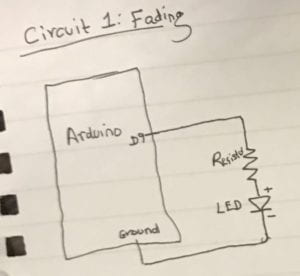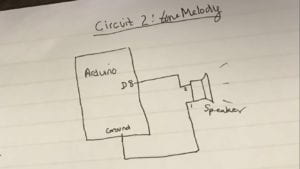Recitation Exercise: 2
Partner: Santiago Salem
Materials:
1 * Arduino Uno
1 * USB A to B cable
1 * breadboard
1 * buzzer
2 * LEDs
2 * 220 ohm resistors
2 * 10K ohm resistors
2 * pushbuttons
2 * arcade buttons
A handful of jumper cables
Circuit 1: Fading
This circuit was fairly simple to build as it required few components (a resistor, an LED, and two cables) and a program already existing as an example on the Arduino app on the computer. We did not come across any problems in building this circuit.


Circuit 2: toneMelody

This circuit was similar to circuit 1, as we simply replaced the LED with a speaker and changed the program to another existing Arduino “example” program in order to have the speaker emit a melody.
Circuit 3: Speed Game


This circuit was a lot more complicated as it involved many more components (some superfluous, i.e. all the extra jumper cables for the sake of pure design) and a much more complex program we obtained from TinkerCad. This circuit took a significantly longer time for us to build partly because we kept running out of jumper cables and having to go cut some more, and largely due to the fact that we encountered to major issues with our assembly. The first was that we neglected the polarity of one of the LEDs — we were able to identify and rectify this problem relatively quickly. The second and more significant issue was that we had a short circuit, so the USB port in the computer would not accept the connection because of the overflow of electricity coming from the Arduino that would have damaged the computer. After we fixed this problem, we were finally able to successfully run the program and play the game. The TinkerCad source for the program of this game can be found following this link: https://www.tinkercad.com/things/6MzvN5rlZlr-race-the-led-spring19.
Question 1
In my daily life, I use computers in the laziest way possible; the only action required of me is from my fingertips and my attention. In this case (lab), we used a combination of a multimedia computer and a micro-controller which both interacted with each other following our interaction with them in order to output the ultimate goals: for the LED to fade, for the speaker to play the melody, and for the speaker and LEDs to indicate the progress of the speed game’s players. The speed game is an example of parallel events, as each player’s ability to quickly and repeatedly click the button was measured simultaneously and individually until the time was up, at which point the program would count the player’s numbers against each other to determine the winner and light their side’s LED. Interaction is the combination of both an action and a reaction, that either occur serially or simultaneously.
Question 2
If I had a 100,000 LEDs of all colors and brightness, I would design a surface that would serve as either the wall (and obviously light) or the floor of a swimming pool. When turned on, it would light up all the LEDs and I’d program it so that certain color LEDs turn on and off periodically to create an interesting and cool effect that would be reflected through the water and that could be perceived from above the water’s surface.